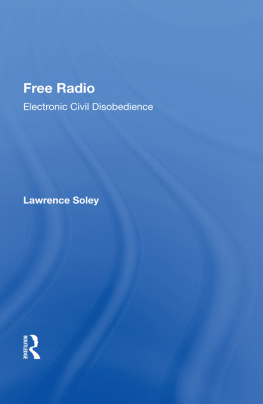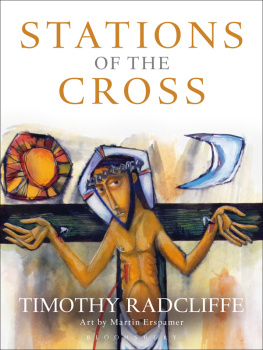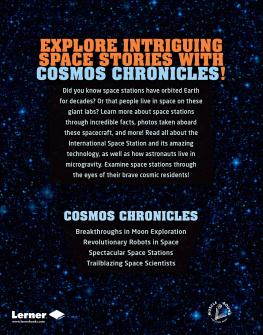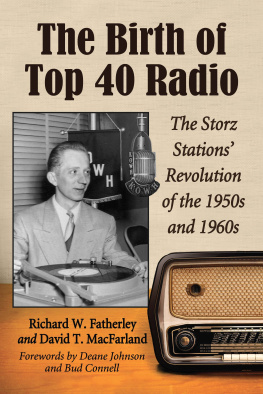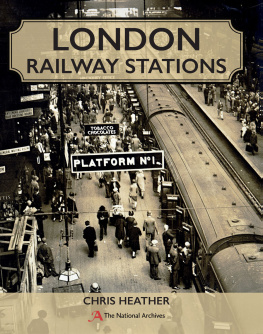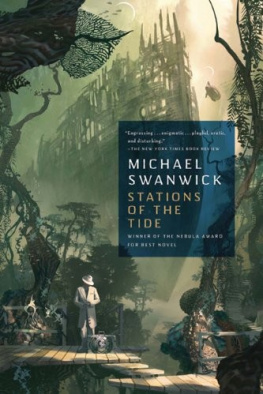Sounds of Change
2008 The University of North Carolina Press
All rights reserved
Designed by Eric M. Brooks
Typeset in Quadraat, Quadraat Sans, and Quartz
Bold by Tseng Information Systems, Inc.
Manufactured in the United States of America
The paper in this book meets the guidelines for permanence and durability of the Committee on Production Guidelines for Book Longevity of the Council on Library Resources.
The University of North Carolina Press has been a member of the Green Press Initiative since 2003.
Library of Congress Cataloging-in-Publication Data Sterling, Christopher H., 1943
Sounds of change: a history of FM broadcasting in America / Christopher H. Sterling and Michael C. Keith.
p. cm.
Includes bibliographical references and index.
ISBN 978-0-8078-3215-8 (cloth: alk. paper)
ISBN 978-0-8078-5888-2 (pbk.: alk. paper)
1. Radio broadcastingUnited StatesHistory. 2. FM broadcastingUnited StatesHistory. I. Keith, Michael C., 1945II. Title.
PN1991.3.U6S78 2008
384.540973dc22 2007046716
cloth 12 11 10 09 08 5 4 3 2 1
paper 12 11 10 09 08 5 4 3 2 1
Contents
Tables, Diagrams, and Maps
TABLES
1.1. Pioneering Experimental FM Stations, 19341940
2.1. Commercial FM Stations Operating by Late 1944
3.1. Transit-Radio Markets as of Mid-1950
4.1. New FM-Station Classification, 19621963
7.1. Single-Market Station Ownership as Allowed under the 1996 Act
7.2. Largest Group Owners of Commercial Radio Stations, 19962007
7.3. Decline in Number of Radio-Station Owners in the Top Ten U.S. Markets, 19962007
7.4. The Number of Radio Stations Owned by Ethnic Minorities, 19902000 and 2007
A.1. AM-Station Classifications
A.2. FM-Station Classifications
B.1. Postwar FM Stations, 19451957
B.2. FM-Station Expansion, 19452005
B.3. FM Program Format Trends, 19661978
B.4. FM Program Format Trends, 19902004
B.5. Postwar FM-Receiver Sales, 19461957
B.6. FM-Receiver Sales and Penetration, 19501980
B.7. FM-Receiver Availability in Selected Markets, 19581965
B.8. FM-Receiver Availability in Selected Markets, 19661975
B.9. FM-Audience Listening Share in Selected Markets, 19672002
B.10. Share of Total National Radio Audience, 19802005
DIAGRAMS
2.1. Changing FM Allocations, 19371945
A.1. Skywaves, Groundwaves, and Direct Waves
A.2. AM Wave
A.3. FM Wave
A.4. Frequency-Response Comparison
A.5. Two-Station Stereo
A.6. FM Multiplexed Stereo
MAPS
3.1. Projected CBS FM Network, 1946
3.2. Continental Network, 1947
3.3. Wisconsin FM Network, 1952
C.1. FM Coverage, 1949
C.2. FM Coverage, 1957
C.3. FM Coverage, 1966
C.4. FM Coverage, 1975
C.5 FM Coverage, 2005
Foreword
BUILDING COMMERCIAL FM
Having begun a career in FM broadcasting between what this book describes as the dismal and dominance eras, I now look back on the early years of FM radio with great pride. With this short preamble to this outstanding record of FMs trials and tribulations, I salute that diverse group of people, with varying agendas and marketplaces, who came together and developed FM into its current position as Americas leading commercial radio choice.
Early commercial FM radio operatorsthose in the late 1950s and early 1960swere unsure whether FMs rather esoteric programming could effectively compete for AM radios advertising dollars. The few FM radios in use throughout the country made time and program sales extremely difficult. Fortunately, the advent of stereo FM in 1961 accelerated set sales for both the home and the all-important car-radio market, which in turn boosted the growth of FM advertising dollars by the late 1960s.
So how did FMs position change over those two decades? As witnessed so effectively in the following chapters, between 1960 and 1980 consumers of radio advertising time discovered the effectiveness of the new and improved radio medium. Stereo FM radios commercial success rewarded the longtime investment by its independent entrepreneurs and group owners. These were men and women who recognized FMs potential and invested heavily in making it a viable entertainment and advertising medium.
A case in point, which this writer personally witnessed in Houston, Texas, involved pioneer TV broadcaster Paul Taft. In November 1958 he convinced me to leave television in Denver to join him in a great new venture managing his Class C FM radio station, which he had just purchased from the Houston Post Company for $10,000including studio, transmitter, antenna, and extensive program library. As was the case with some other early FM operators, Tafts primary reason for buying this facility was to utilize its subcarrier to transmit Muzak background music to business customers, eliminating costly telephone-line charges. He was a great entrepreneur and reinvested all Muzak profits into main channel development of his over-the-air station, KHGMwhich he soon dubbed The Home of Good Music. Recognizing the potential of FMs quality sound, he was willing to underwrite the expense of hiring professional people, making technical improvements, and creating Americas first twenty-four-hour FM stereo station in the early 1960s. By 1980 KODA-FM (its new call sign) became one of the markets top three stations, consistently leading all Houston stations among audiences age twenty-five to fifty-fourthe demographic most desired by advertisers. This is but one of hundreds of cases in which independent-operator belief in the high-fidelity medium led to its eventual commercial success. With thousands of new FM stations going on the air after 1960, property values in the 1980S and 1990s accelerated explosively, handsomely rewarding its supporters and advocates.
Those difficult early days of commercial FM radio are now far behind us. As radio executives search for successful programming platforms for the twenty-first century, there are countless sales and marketing professionals successfully selling FM radio time across the United States. Their work is being ably assisted by the efforts of a revitalized Radio Advertising Bureau.
The big question today appears to be whether FM radio will retain its position as the major distribution source of music programming in the United States during the twenty-first century. This writers short but considered reply is that three things are required to make this happen: (i) creative programming; (2) brave management; and (3) successful marketing of high-definition, digital FM receivers.
In this book, Chris Sterling and Mike Keith provide a cogent and fascinating history of FM. It is an excellent resource on the growth and nurturing of FM radio in America, a period that many of us so proudly remember. As for the future of FM, a still-apt opinion was voiced by FCC commissioner Robert Bartley at the 1963 annual convention of the National Association of FM Broadcasters in Chicago. Bartley, who had worked in FM earlier in his career, ended his keynote address with these words:
During about a two-decade history of FM broadcasting, many knowledgeable and influential broadcasters and manufacturers have earnestly predicted that FM would die on the vine. Many of these same people have subtly fought FM, but FM did not die on the vine. It has had some setbacks and close calls, but it has survived like a cat with nine lives. It has survived because its too good a thing to kill off. It is good for the listener because the signal is reliable and its quality of reception is infinitely better. FM radio has survived and progressed because it has offered a service which has become a symbol of quality. I urge you to keep it a symbol of quality.


